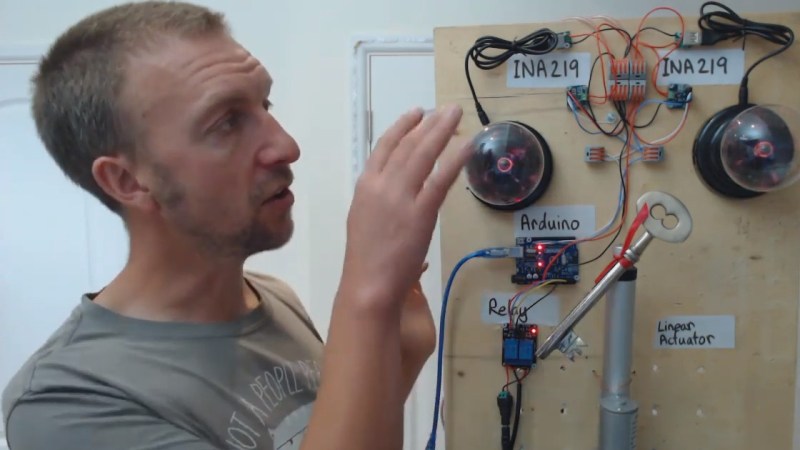If you like solving puzzles out in the real world, you’ve probably been to an escape room before, or are at least familiar with its concept of getting (voluntarily) locked inside a place and searching for clues that will eventually lead to a key or door lock combination that gets you out again. And while there are plenty of analog options available to implement this, the chances are you will come across more and more electronics-infused puzzles nowadays, especially if it fits the escape room’s theme itself. [Alastair Aitchison] likes to create such puzzles and recently discovered how he can utilize a USB powered plasma globe as a momentary switch in one of his installations.
The concept is pretty straightforward, [Alastair] noticed the plasma globe will draw significantly more current when it’s being touched compared to its idle state, which he measures using an INA219 current shunt connected to an Arduino. As a demo setup in his video, he uses two globes that will trigger a linear actuator when touched at the same time, making it an ideal multiplayer installation. Whether the amount of fingers, their position on the globe, or movement make enough of a reliable difference in the current consumption to implement a more-dimensional switch is unfortunately not clear, but definitely something worth experimenting with.
In case you’re planning to build your own escape room and are going for the Mad Scientist Laboratory theme, you’ll obviously need at least one of those plasma globes sparking in a corner anyway, so this will definitely come in handy — maybe even accompanied by something slightly larger? And for all other themes, you can always resort to an RFID-based solution instead.
















The use of plasma ball as touch sensors is awesome.
Nevertheless, are not INA219 a bit of overkill here compared to simply sensing the current with Arduino’s ADC through a resistor ?
I was thinking not only this but just to switch a relay the arduino itself is overkill…
The tutorial is intended to illustrate how plasma balls can be used as input by demonstrating them using a standalone, self-contained puzzle, for which I agree an Arduino is not required. However, in the context of an escape room, you’d normally expect to be able to remotely monitor and/or override the status of individual props from room control software, e.g. via MQTT over Wi-Fi or an ethernet connection. It’s also common that you might want to incorporate additional feedback mechanisms besides the relay, such as triggering audio samples, for example. For those reasons, I tend to create all my puzzles around a local Arduino (or similar microprocessor) – it just provides extensibility and modularity to extend the project in the future.
Kevin, quick question. How would you do a work around without an arduino? (sorry, just trying to learn this stuff for our room – I’m on the struggle bus sometimes)
Nice discovery! Is it possible to tell how many fingers are touching the globe or is the resolution limited to touching / not touching?
Quickly testing on my random USB plasma globe…
My multimeter says that it’s pretty constantly 300mA DC, but the “AC” reading ranges from 43mA when I’m no-where near it, to 42mA when I hold my palm two inches away from it, all the way down to 23mA when I cover the whole surface with my hands. And it’s slowly drifting down as time goes on – I assume as the inverter inside gets hot.
Mine basically acts like a capacitive proximity sensor. The hard part isn’t getting a continuous measurement out of it, it’s calibrating that measurement.
So some resolution is possible unless you’re expecting extended periods of use at which point you need a somewhat fancier detection solution. Interesting that the current drops with closer proximity, I would have expected the opposite.